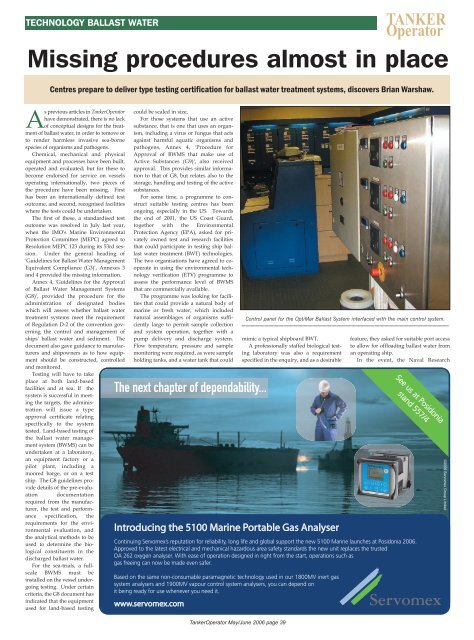Navigation standards slammed - Tanker Operator
Navigation standards slammed - Tanker Operator
Navigation standards slammed - Tanker Operator
You also want an ePaper? Increase the reach of your titles
YUMPU automatically turns print PDFs into web optimized ePapers that Google loves.
p39-42.qxd 09/05/2006 12:12 Page 1<br />
TECHNOLOGY BALLAST WATER<br />
TANKER<br />
<strong>Operator</strong><br />
Missing procedures almost in place<br />
Centres prepare to deliver type testing certification for ballast water treatment systems, discovers Brian Warshaw.<br />
As previous articles in <strong>Tanker</strong><strong>Operator</strong><br />
have demonstrated, there is no lack<br />
of conceptual designs for the treatment<br />
of ballast water, in order to remove or<br />
to render harmless invasive sea-borne<br />
species of organisms and pathogens.<br />
Chemical, mechanical and physical<br />
equipment and processes have been built,<br />
operated and evaluated; but for these to<br />
become endorsed for service on vessels<br />
operating internationally, two pieces of<br />
the procedure have been missing. First<br />
has been an internationally defined test<br />
outcome, and second, recognised facilities<br />
where the tests could be undertaken.<br />
The first of these, a standardised test<br />
outcome was resolved in July last year,<br />
when the IMO's Marine Environmental<br />
Protection Committee (MEPC) agreed to<br />
Resolution MEPC 123 during its 53rd session.<br />
Under the general heading of<br />
'Guidelines for Ballast Water Management<br />
Equivalent Compliance (G3)', Annexes 3<br />
and 4 provided the missing information.<br />
Annex 4, 'Guidelines for the Approval<br />
of Ballast Water Management Systems<br />
(G8)', provided the procedure for the<br />
administration of designated bodies<br />
which will assess whether ballast water<br />
treatment systems meet the requirement<br />
of Regulation D-2 of the convention governing<br />
the control and management of<br />
ships' ballast water and sediment. The<br />
document also gave guidance to manufacturers<br />
and shipowners as to how equipment<br />
should be constructed, controlled<br />
and monitored.<br />
Testing will have to take<br />
place at both land-based<br />
facilities and at sea. If the<br />
system is successful in meeting<br />
the targets, the administration<br />
will issue a type<br />
approval certificate relating<br />
specifically to the system<br />
tested. Land-based testing of<br />
the ballast water management<br />
system (BWMS) can be<br />
undertaken at a laboratory,<br />
an equipment factory or a<br />
pilot plant, including a<br />
moored barge, or on a test<br />
ship. The G8 guidelines provide<br />
details of the pre-evaluation<br />
documentation<br />
required from the manufacturer,<br />
the test and performance<br />
specification, the<br />
requirements for the environmental<br />
evaluation, and<br />
the analytical methods to be<br />
used to determine the biological<br />
constituents in the<br />
discharged ballast water.<br />
For the sea-trials, a fullscale<br />
BWMS must be<br />
installed on the vessel undergoing<br />
testing. Under certain<br />
criteria, the G8 document has<br />
indicated that the equipment<br />
used for land-based testing<br />
could be scaled in size.<br />
For those systems that use an active<br />
substance, that is one that uses an organism,<br />
including a virus or fungus that acts<br />
against harmful aquatic organisms and<br />
pathogens, Annex 4, 'Procedure for<br />
Approval of BWMS that make use of<br />
Active Substances (G9)', also received<br />
approval. This provides similar information<br />
to that of G8, but relates also to the<br />
storage, handling and testing of the active<br />
substances.<br />
For some time, a programme to construct<br />
suitable testing centres has been<br />
ongoing, especially in the US. Towards<br />
the end of 2001, the US Coast Guard,<br />
together with the Environmental<br />
Protection Agency (EPA), asked for privately<br />
owned test and research facilities<br />
that could participate in testing ship ballast<br />
water treatment (BWT) technologies.<br />
The two organisations have agreed to cooperate<br />
in using the environmental technology<br />
verification (ETV) programme to<br />
assess the performance level of BWMS<br />
that are commercially available.<br />
The programme was looking for facilities<br />
that could provide a natural body of<br />
marine or fresh water, which included<br />
natural assemblages of organisms sufficiently<br />
large to permit sample collection<br />
and system operation, together with a<br />
pump delivery and discharge system.<br />
Flow temperature, pressure and sample<br />
monitoring were required, as were sample<br />
holding tanks, and a water tank that could<br />
The next chapter of dependability...<br />
<strong>Tanker</strong><strong>Operator</strong> May/June 2006 page 39<br />
Control panel for the OptiMar Ballast System interfaced with the main control system.<br />
mimic a typical shipboard BWT.<br />
A professionally staffed biological testing<br />
laboratory was also a requirement<br />
specified in the enquiry, and as a desirable<br />
Introducing the 5100 Marine Portable Gas Analyser<br />
feature, they asked for suitable port access<br />
to allow for offloading ballast water from<br />
an operating ship.<br />
In the event, the Naval Research<br />
Continuing Servomex’s reputation for reliability, long life and global support the new 5100 Marine launches at Posidonia 2006.<br />
Approved to the latest electrical and mechanical hazardous area safety <strong>standards</strong> the new unit replaces the trusted<br />
OA 262 oxygen analyser. With ease of operation designed in right from the start, operations such as<br />
gas freeing can now be made even safer.<br />
Based on the same non-consumable paramagnetic technology used in our 1800MV inert gas<br />
system analysers and 1900MV vapour control system analysers, you can depend on<br />
it being ready for use whenever you need it.<br />
www.servomex.com<br />
See us at Posidonia<br />
stand stand 557/4 557/4<br />
©2006 Servomex Group Limited
















